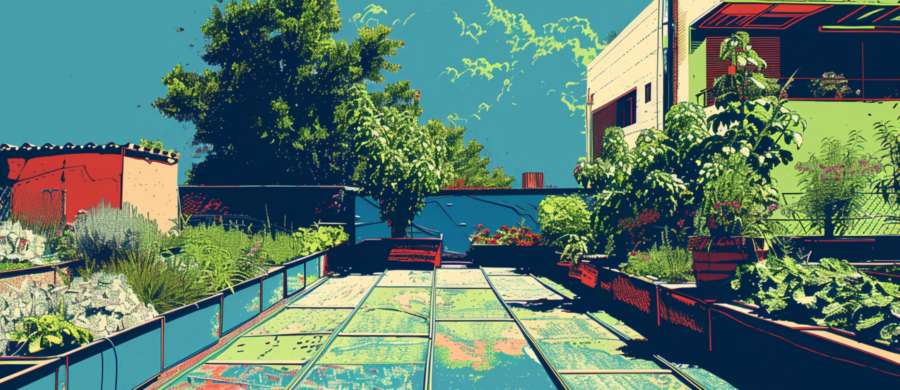A Fungus Among Us, Fixing Floods
Beneath your feet, a silent revolution is happening. It doesn’t carry protest signs or chant slogans, but it does devour dead things and soak up water like a biological sponge. Mycelium, the intricate web of fungal threads that humbly toils in the shadows, is turning out to be an ecological superhero in the battle against waterlogged landscapes.Forget expensive drainage systems, complicated trenching, and those “miracle” garden fixes sold on late-night infomercials. Nature has already designed a solution, and it’s been around for millions of years. The answer lies in fungi—specifically, their ability to slurp up excess moisture and make soil more permeable. Who knew that something so closely associated with pizza toppings could also be the key to preventing floods?
The Mycelial Highway: How Fungi Absorb Water
If you’ve ever picked up a rotting log or an old pile of leaves, you’ve probably encountered mycelium. It’s that white, thread-like stuff weaving through organic matter like an underground internet, only without the conspiracy theories and cat videos. This mycelial network plays a crucial role in soil health, and one of its standout abilities is absorbing and redistributing water.Mycelium acts like nature’s sponge, soaking up moisture during heavy rains and gradually releasing it back into the soil. This isn’t just good for preventing standing water; it also keeps plant roots from rotting while maintaining a steady hydration level during drier spells. It’s the ultimate water management system, minus the need for bureaucratic oversight or budget cuts.
Certain species, like Oyster mushrooms (*Pleurotus ostreatus*) and Wine Cap mushrooms (*Stropharia rugosoannulata*), are particularly good at this. They grow quickly, form dense networks, and have an insatiable appetite for organic material. When introduced to problem areas, these fungi not only improve drainage but also enhance soil structure, making it easier for water to filter through rather than pooling on the surface.
Better Than French Drains (And Less Work)
Traditional drainage solutions—like French drains, trenches, and buried pipes—work, but they also require labor, materials, and the patience of a saint. Plus, once they’re in place, they do one thing and one thing only: direct water elsewhere. Mycelium, on the other hand, multitasks.Not only does it absorb and distribute water, but it also breaks down organic matter, improves soil structure, and even forms symbiotic relationships with plants to help them grow stronger. Instead of just shoving water from one place to another like a frustrated bartender clearing off a sticky counter, fungi actually make the soil more hospitable in the process.
A Natural Solution That Works With the Earth
Unlike artificial drainage systems that often require ongoing maintenance, mycelium operates on autopilot. It doesn’t clog, corrode, or require replacement parts from some overpriced specialty store. Once established, it continues working indefinitely, provided it has organic material to feed on.Adding fungi to problem areas is relatively simple: scatter mushroom spores or plug spawn into mulch, wood chips, or compost and let nature take over. Given time, the mycelial network will grow, helping to stabilize soil moisture and enhance permeability. It’s a solution that requires patience rather than brute force—a concept some homeowners might find refreshingly different from the usual “buy more stuff” approach.
The Unexpected Side Benefits
Beyond water management, fungal networks come with some interesting perks. Many species used for soil improvement, like Wine Cap mushrooms, are also edible, meaning your backyard drainage system might double as a gourmet mushroom farm.Additionally, mycelium naturally filters out pollutants and breaks down contaminants. Studies have shown that fungi can even help decompose oil spills, pesticides, and heavy metals. While most homeowners won’t be dealing with an Exxon Valdez-scale disaster in their backyard, knowing that your fungi are quietly detoxifying the soil is a nice bonus.
How to Get Started with Fungal Drainage
If you’re intrigued by the idea of recruiting mushrooms as your personal water management team, the good news is that it’s remarkably easy to get started. You won’t need a degree in mycology or a secret membership to an underground fungi society (though that does sound intriguing).1. Choose the Right Fungi – Not all mushrooms are created equal when it comes to drainage. Oyster mushrooms (*Pleurotus ostreatus*), Wine Cap mushrooms (*Stropharia rugosoannulata*), and Garden Giant mushrooms are all excellent choices. They establish quickly, thrive in various conditions, and work tirelessly without demanding overtime pay.
2. Prepare the Ground – Mycelium thrives in organic matter, so areas covered in mulch, wood chips, straw, or compost make the best fungal nurseries. Avoid compacted soil—fungi like their workspace aerated, much like a baker prefers a well-floured countertop.
3. Inoculate the Area – Introducing fungi to your soil is as simple as scattering mushroom spores or using spawn plugs (essentially fungal “starter kits”). Spread them over prepared areas and give them time to weave their underground network.
4. Keep Things Moist (But Not Drenched) – Mycelium needs moisture to get started, but it doesn’t appreciate standing in puddles. Think of it like a houseplant: water it enough to keep things thriving but not so much that it feels like a swamp.
5. Let Nature Take Over – Once established, the fungal network will do its thing. Unlike a traditional drainage system that needs maintenance, fungi are self-sustaining, provided they have organic matter to feed on. Over time, they’ll improve soil structure, absorb excess moisture, and even enrich the ground with nutrients.
The Future of Fungus-Powered Drainage
Fungi are finally getting the respect they deserve. Scientists and environmentalists are studying ways to use mycelium for large-scale flood prevention, soil restoration, and even urban drainage solutions. Imagine a world where city sidewalks and parks are laced with mycelial networks that silently prevent flooding while making the soil healthier. It sounds futuristic, but it’s actually ancient technology—nature has been running this system for millions of years.While large-scale adoption is still in the works, homeowners, gardeners, and land managers can start using fungal drainage solutions right now. The benefits go beyond flood prevention: healthier soil, better plant growth, and even a potential backyard mushroom harvest. It’s a win-win-win, with mycelium doing the hard work while you sit back and admire your naturally improved landscape.
Mushrooming Possibilities
It turns out fungi aren’t just good on pizzas and in questionable foraging adventures—they’re also nature’s engineers, quietly keeping landscapes balanced. Mycelium offers a solution that’s efficient, self-sustaining, and eco-friendly, making it a powerful alternative to traditional drainage methods.So, the next time you see mushrooms sprouting in your yard, don’t reach for the weed killer. They might just be the tiny, unassuming allies working behind the scenes to keep your soil healthy and your landscape flood-free. Who knew the future of drainage could be so… delicious?
Article kindly provided by 1800waterdamage.com/northern-utah/


